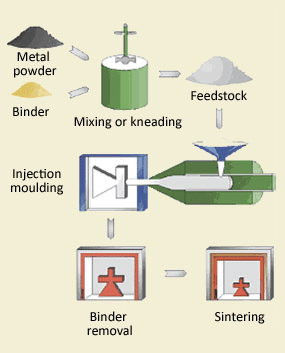Resource Library
Request a Quote
An overview of the Metal Injection Molding process
A simple concept, a complex process
jection
molding to form complex components was first
developed for ceramic components.
In the 1970’s this process was developed to allow the processing of metal powders by Raymond Wiech in the US, widely considered the inventor of the MIM process. The flow diagram in Fig. 2 shows the sequence of processing steps.
- Production of a homogeneous powder-binder
mix with a high metal powder loading and
sufficient viscosity for injection molding
- Development of economical binder removal
processes providing shape retention
- Sintering to high density and dimensional
accuracy.

Fig. 2 The metal injection molding process
(Courtesy IFAM, Germany)
The key steps
The primary raw materials for MIM are metal powders and a thermoplastic binder. The binder is only an intermediate processing aid and removed from the products after injection molding. The properties of the powder determine the final properties of the MIM product.
The blended powder mix is worked into the plastified binder at elevated temperature using a kneader or shear roll extruder. The intermediate product is the so-called feedstock. It is usually granulated with granule sizes of several millimetres, as is common in the plastic injection molding industry.
Feedstock can either be purchased "ready to
mould" from a number of international suppliers, or
it can be manufactured in-house by a MIM producer if
the necessary skills and knowledge are available.
Injection molding
The ‘green’ MIM parts are formed in an injection
molding process equivalent to the forming of
plastic parts. The variety of part geometries that
can be produced by this process are similar to the
great variety of plastic components.
Binder removal
The subsequent binder removal process serves to
obtain parts with an interconnected pore network
without destroying the shape of the components. The
types of binder removal processes applied are
further explained later in this introduction. At the
end of the binder removal process there is often
still some binder present in the parts holding the
metal powder particles together, but the pore
network allows to evaporate the residual binder
quickly in the initial phase of sintering, at the
same time as sintering necks start to grow between
the metallic particles.
Sintering
The sintering process leads to the elimination of most of the pore volume formerly occupied by the binder. As a consequence, MIM parts exhibit a substantial shrinkage during sintering. The linear shrinkage is usually as high as 15 to 20% (Fig. 3). If required, sintered MIM parts may be further processed by conventional metalworking processes like heat treatments or surface treatments in the same way as cast or wrought parts.
For certain applications, such as the automotive,
medical and aerospace sectors, Hot Isostatic
Pressing (HIP) can be used to completely remove any
residual porosity. As MIM parts are typically small,
this can be relatively cost effective for critical
components.

(Courtesy BASF AG, Germany)